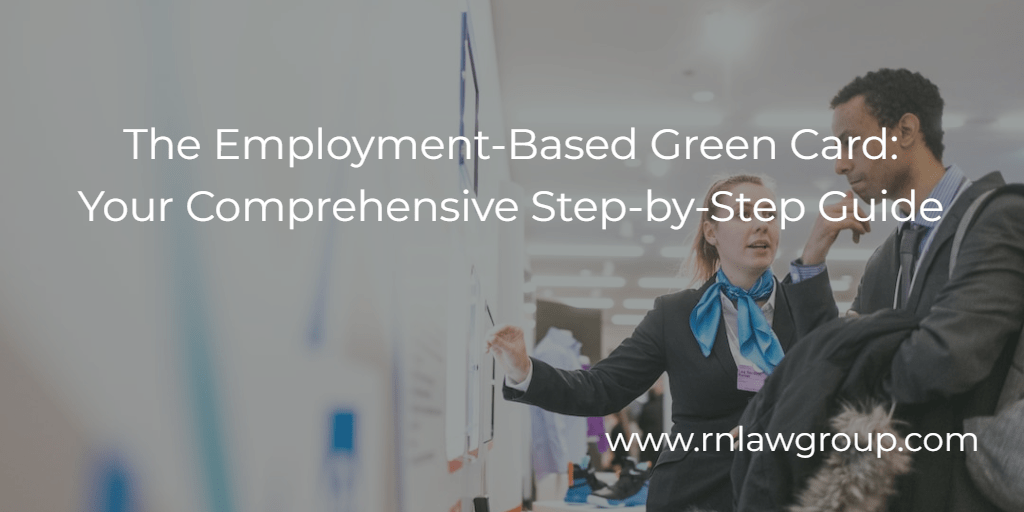
The Employment-Based Green Card: Your Comprehensive Step-by-Step Guide
The employment-based green card process is a multi-step process that allows foreign nationals to live and work permanently in the U.S. The process can be complicated and lengthy, but for those seeking permanent residency in the U.S., it is an essential step to achieving that goal. In this article, we will go through the steps of the employment-based green card process in detail.
Step 1: PERM/Labor Certification
The PERM/Labor Certification process is usually the first step in the employment-based green card process. The process is designed to ensure that there are no qualified U.S. workers available for the position and that the foreign worker will not negatively impact the wages and working conditions of U.S. workers.
Submit the Prevailing Wage Application
The employer begins the PERM process by drafting the job description for the sponsored position. Once the job details are finalized, a prevailing wage application is submitted to the Department of Labor (DOL). The prevailing wage rate is defined as the average wage paid to similarly employed workers in a specific occupation in the area of intended employment. The DOL issues a Prevailing Wage Determination (PWD) based on the specific position, job duties, requirements for the position, the area of intended employment, travel requirements (if any), among other things. The prevailing wage is the rate the employer must at least offer the permanent position at. It is also the rate that must be paid to the employee once the green card is received. Current processing times for prevailing wage applications are 6 to 7 months.
Conduct the Recruitment Process
PERM regulations require a sponsoring employer to test the U.S. labor market through various recruitment methods for “able, willing, qualified, and available” U.S. workers. Generally, the employer has 2 options when deciding when to begin the recruitment process. The employer can begin advertising (1) while the prevailing wage application is pending or (2) after the PWD is issued.
All PERM applications, whether for a professional or non-professional occupation, require the following recruitment efforts:
- 30 day job order with the State Workforce Agency serving the area of intended employment;
- Two Sunday print advertisements in a newspaper of general circulation in the area of intended employment, most appropriate to the occupation and most likely to bring responses from able, willing, qualified, and available U.S. workers; and
- Notice of Filing to be posted at the job site for a period of 10 consecutive business days.
In addition to the mandatory recruitment mentioned above, the DOL requires 3 additional recruitment efforts to be posted. The employer must choose 3 of the following:
- Job Fairs
- Employer’s company website
- Job search website
- On-Campus recruiting
- Trade or professional organization
- Private employment firms
- Employee referral program
- Campus placement office
- Local or ethnic newspaper; and
- Radio or TV advertisement
During the recruitment process, the employer may be reviewing resumes and conducting interviews of U.S. workers. The employer must keep detailed records of their recruitment efforts, including the number of U.S. workers who applied for the position, the number who were interviewed, and the reasons why they were not hired.
Submit the PERM/Labor Certification Application
After the PWD is issued and recruitment is complete, the employer can submit the PERM application if no qualified U.S. workers were found. Currently the DOL is taking 8 to 9 months to process PERM applications after submission. The day the PERM application is filed establishes the beneficiary’s priority date and determines his/her place in line in the green card visa queue.
Respond to PERM/Labor Certification Audit (if any)
An employer is not required to submit supporting documentation when a PERM application is filed. Therefore, the DOL implements a quality control process in the form of audits to ensure compliance with all PERM regulations. In the event of an audit, the DOL typically requires:
- Evidence of all recruitment efforts undertaken (copies of advertisements placed and Notice of Filing);
- Copies of applicants’ resumes and completed employment applications; and
- A recruitment report signed by the employer describing the recruitment steps undertaken and the results achieved, the number of hires, and, if applicable, the number of U.S. applicants rejected, summarized by the specific lawful job-related reasons for such rejections.
If an audit is issued on a case, 3 to 4 months are added to the total processing time of the PERM application.
Receive the Approved PERM/Labor Certification
If the PERM application is approved, the employer will receive it from the DOL. The approved PERM/Labor Certification confirms that there are no qualified U.S. workers available for the position and that the beneficiary will not negatively impact the wages and working conditions of U.S. workers.
Step 2: I-140 Immigrant Petition
Once the PERM application has been approved, the next step is to file an I-140 immigrant petition with U.S. Citizenship and Immigration Services (USCIS). The petition must include the approved PERM application and evidence of the beneficiary’s qualifications for the sponsored position. Please note, depending on the preference category and country of birth, a beneficiary may be eligible to file the I-140 immigrant petition and the I-485 adjustment of status application concurrently if his/her priority date is current.
At the I-140 petition stage, the employer must also demonstrate its ability to pay the beneficiary the proffered wage from the time the PERM application is filed to the time the green card is issued. There are 3 ways to demonstrate ability to pay:
- Evidence that the wage paid to the beneficiary is equal to or greater than the proffered wage (pay-stubs, W-2s);
- Evidence that the company’s net income is equal to or greater than the proffered wage (annual report, tax return, or audited financial statement); OR
- Evidence that the company’s net assets are equal to or greater than the proffered wage (annual report, tax return, or audited financial statement).
In addition, it is at this stage that the employer will choose the employment-based preference category for the sponsored position. The category depends on the minimum requirements for the position that was listed on the PERM application and the employee’s qualifications.
There are several categories of employment-based green cards, and each has its own set of requirements. (Please note, some categories may not require an approved PERM application or I-140 petition.) The categories include:
- EB-1: Priority Workers
- EB-2: Professionals Holding Advanced Degrees and Persons of Exceptional Ability
- EB-3: Skilled Workers, Professionals, and Unskilled Workers (Other Workers)
- EB-4: Certain Special Immigrants
- EB-5: Immigrant Investors
After the I-140 petition is filed, USCIS will review it and may request additional information or documentation by issuing a Request for Evidence (RFE).
Step 3: Green Card Application
Once the I-140 immigrant petition is approved, the beneficiary will check the Visa Bulletin to determine if there is an available green card. The actual green card application can only be filed if the beneficiary’s priority date is current, meaning a green card is immediately available to the beneficiary.
Every month, the Department of State publishes the Visa Bulletin, which summarizes the availability of immigrant visa (green card) numbers and indicates when a green card has become available to an applicant based on their preference category, country of birth, and priority date. The date the PERM application is filed establishes the beneficiary’s priority date. In the employment-based immigration system, Congress set a limit on the number of green cards that can be issued each year. That limit is currently 140,000. This means that in any given year, the maximum number of green cards that can be issued to employment-based applicants and their dependents is 140,000.
Once the beneficiary’s priority date is current, he/she will either go through adjustment of status or consular processing to receive the green card.
Adjustment of Status
Adjustment of status involves applying for the green card while in the U.S. After an adjustment of status application is filed (Form I-485), the beneficiary is notified to appear at an Application Support Center for biometrics collection, which usually involves having his/her picture and signature taken and being fingerprinted. This information will be used to conduct required security checks and for eventual creation of a green card, employment authorization (work permit) or advance parole document. The beneficiary may be notified of the date, time, and location for an interview at a USCIS office to answer questions under oath or affirmation regarding his/her application. Not all applications require an interview. USCIS officials will review the beneficiary’s case to determine if it meets one of the exceptions. If the interview is successful and USCIS approves the application, the beneficiary will receive the green card.
Consular Processing
Consular processing involves applying for the green card at a U.S. consulate in the beneficiary’s home country. The consular office sets up an appointment for the beneficiary’s interview when his/her priority date becomes current. If the consular officer grants the immigrant visa, the beneficiary is given a Visa Packet. The beneficiary will pay a USCIS Immigrant Fee which is used by USCIS to process the Visa Packet and produce the green card. The beneficiary will present the Visa Packet to the U.S. Customs and Border Protection (CPB) officer at the port of entry. The CBP officer will inspect and determine whether to admit the beneficiary into the U.S. If admitted, the beneficiary will receive the green card in the mail. The green card serves as proof of permanent residency in the U.S. and allows the individual to live and work in the U.S.
Because the U.S. immigration system can be tricky to navigate, it is always best to contact a qualified immigration attorney to help come up with the proper solution for each individual case.
By: Camille Joson
Camille Joson is a Senior Associate Attorney in Reddy Neumann Brown PC’s PERM Labor Certification Department, where she assists clients in the beginning stages of the green card process.

